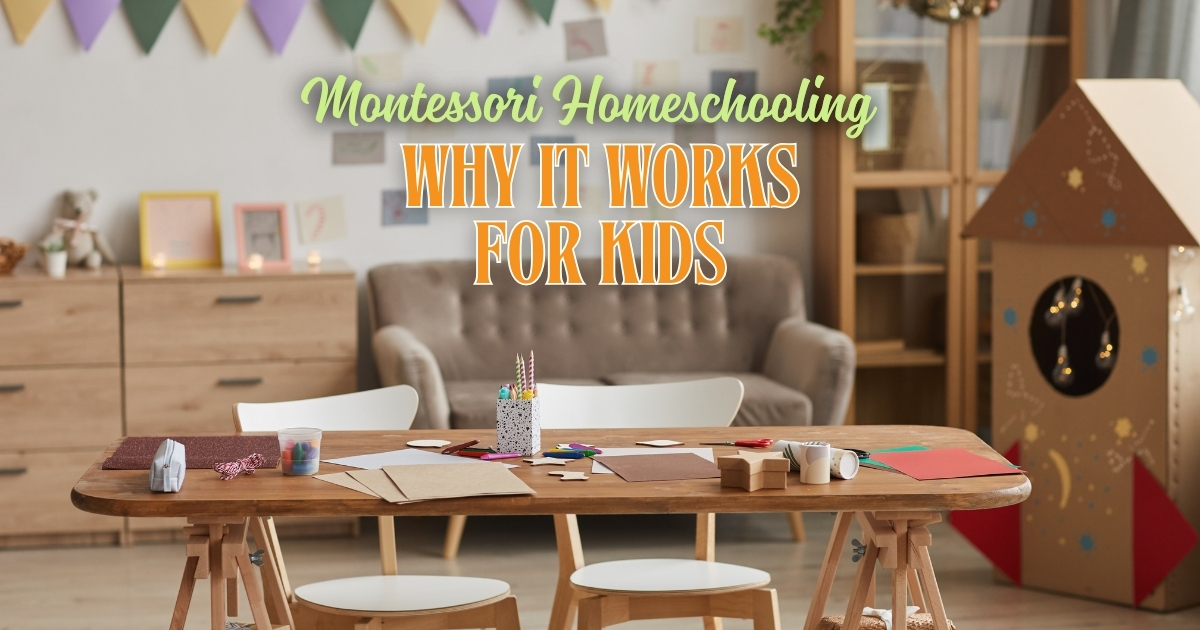Homeschooling is a growing trend among families seeking personalized and effective education for their children. Among the numerous approaches that parents explore, Montessori homeschooling stands out as a method that nurtures independence, fosters creativity, and promotes a lifelong love of learning.
This blog explores the benefits of Montessori homeschooling and why it works so well for kids. It also provides an overview of foundational Montessori homeschool methods, offering actionable insights for parents who want to incorporate this approach into their daily routines.
Why Montessori Works For Kids
The Montessori method, developed by Italian educator Maria Montessori, is rooted in understanding how children learn best. Unlike more traditional, one-size-fits-all teaching styles, Montessori focuses on meeting children where they are developmentally and helping them progress at their own pace. Here are the reasons why this method works so effectively for kids:
- Child-Centered Learning
Montessori education emphasizes the uniqueness of each child. Instead of teaching every child in the exact same way, it allows kids to choose from a variety of activities within a prepared environment. This approach respects natural learning rhythms, enabling children to follow their interests and work on skills when they feel ready.
- Promotes Independence
A key principle of Montessori is fostering independence. From a young age, children are encouraged to make choices about their learning and take responsibility for completing tasks. Montessori classrooms (or homeschool spaces) are designed so children can access materials, clean up after themselves, and function independently. This builds confidence and gives kids the skills they need to transition into adulthood.
- Hands-On, Experiential Learning
Montessori prioritizes hands-on learning materials that engage all the senses. For example:
- Math concepts are taught using bead chains or wooden number blocks.
- Geography lessons incorporate globe hands-on activities and puzzle maps.
These tangible tools make abstract ideas more concrete, helping kids gain a deeper understanding of the material.
- Focus on Intrinsic Motivation
Instead of external rewards like grades or gold stars, Montessori emphasizes intrinsic motivation. Children learn to value the process of discovery and take pride in their accomplishments. This helps kids develop a genuine love for learning and ensures they stay curious and engaged throughout their education.
- Supports Emotional Development
Montessori doesn’t just focus on academics; it’s concerned with emotional and social growth as well. By encouraging respect for others, collaboration, and kindness, this method prepares children to develop healthy relationships and emotional intelligence. The multi-age group settings, which are also effective for homeschooling, allow younger kids to learn from older peers while older children practice leadership skills.
Real-Life Example:
Imagine a seven-year-old learning multiplication through traditional rote memorization versus using Montessori-style beadwork. The hands-on material allows the child to physically group items into sets, making the math process not just easier to understand but also more enjoyable. This kind of practical, sensory-based learning is a hallmark of why Montessori connects with kids.

Montessori Homeschool Methods
Integrating Montessori education into a homeschooling environment can feel daunting at first, but it’s entirely doable with preparation and the right materials. Here’s how parents can bring Montessori principles into their home classrooms effectively:
- Prepare a Montessori-Friendly Environment
Creating the right environment is foundational to Montessori homeschooling. Unlike standard at-home setups, Montessori spaces are designed to encourage independence and exploration.
- Organize Materials Thoughtfully
Store educational materials in accessible locations. Use low shelves so kids can grab what they need without assistance. Bins, baskets, or trays can help keep activities tidy and organized.
- Keep It Minimalist
Avoid clutter by limiting available toys and tools to those that align with your child’s current developmental stage. Rotating materials regularly keeps things fresh and engaging.
- Prioritize Natural Materials
Montessori emphasizes using natural, high-quality learning tools like wood, metal, or fabric. These materials are not only more durable but also offer a sensory-rich experience for children.
- Implement Montessori Daily Rhythms
Structure plays a significant role in Montessori homeschooling. While it’s important to allow flexibility, establishing predictable daily rhythms can help kids thrive. Here’s a suggested approach:
- Morning Work Period
Dedicate the morning to uninterrupted “work.” Allow your child to choose activities they’re drawn to, whether it’s practicing math skills, reading, or working on puzzles.
- Outdoors and Physical Activity
Integrate time for nature walks, gardening, or playing outdoors. Physical activity helps reset focus and enhance learning.
- Afternoon Practical Life Tasks
Montessori emphasizes teaching life skills like baking, sewing, or cleaning in fun and engaging ways. Use the afternoon for practical lessons that also develop motor skills and independence.
- Employ Montessori Materials and Lessons
Invest in resources designed specifically for Montessori education:
- Math Tools: Bead chains, sandpaper numbers, and number rods make math concepts hands-on.
- Language Materials: Moveable alphabets and sandpaper letters support reading and writing.
- Practical Life Activities: Incorporate everyday tasks that encourage learning and help children feel connected to their environment. Examples include setting the table or watering plants.
Tip for parents on a budget:
You don’t need to purchase every Montessori material. Many items, like counting beads or sensory trays, can be made at home. Pinterest and Montessori homeschool communities online offer countless DIY ideas.
Unlocking Creativity And Critical Thinking
Montessori homes nurture not just academic knowledge but also creativity and problem-solving skills. These aspects are woven seamlessly into the approach through open-ended exploration and freedom of choice. Children, for instance, might encounter puzzles they must solve or art projects they must complete without predefined outcomes. Working independently yet thoughtfully reinforces critical thinking.
Furthermore, Montessori methods encourage interdisciplinary studies. For example, a lesson on plants may combine science (learning about photosynthesis), geography (discussing ecosystems), and art (drawing flowers). This holistic way of teaching enables children to see connections across subjects, which boosts both creativity and comprehension.
Why This Matters:
Imagine your child building a model bridge out of wood blocks. They experiment, fail, and try again until success. This hands-on, trial-and-error process isn’t about finding the “right” result but building resilience and adaptive thinking—an invaluable life skill.
Common Challenges (and How Montessori Homeschooling Overcomes Them)
Homeschooling parents often face challenges like motivating their children, balancing structure with freedom, or teaching multiple subjects at once. Montessori methods offer practical solutions:
- Challenge: Keeping kids engaged.
Solution: Montessori materials are inherently engaging because they’re self-correcting. For instance, if a child misplaces a number bead, the “error” is immediately visible to them without adult intervention. This builds problem-solving skills and keeps activities exciting.
- Challenge: Juggling kids of different ages.
Solution: The Montessori multi-age approach thrives in homeschools. Younger children often mimic older siblings’ good habits, while older kids develop leadership skills by mentoring.
- Challenge: Maintaining order in homeschool spaces.
Solution: Montessori’s emphasis on organization and tidy habits makes it easier to maintain a productive workspace.
Getting Started With Montessori Homeschooling
For parents interested in transitioning to Montessori homeschooling, here are some steps to help you begin:
1. Research and Educate Yourself
Read books on Montessori philosophy like The Montessori Method by Maria Montessori or explore online homeschooling resources.
2. Start Small
Begin by implementing a few Montessori principles, such as allowing your child to make choices about what they learn or encouraging practical life skills.
3. Join Supportive Communities
There are thriving online groups and forums dedicated to Montessori homeschooling. Engaging with these communities can provide ideas, encouragement, and troubleshooting tips.
4. Be Patient
Transitioning to a Montessori homeschool takes time and experimentation. Observe your kids to see what works best and make adjustments as needed.
By applying these steps and gradually incorporating Montessori ideals, parents can create a rich, engaging home learning environment that benefits their kids academically and emotionally.
Montessori homeschooling isn’t just a teaching philosophy—it’s a mindset that recognizes and respects the individuality of each child. With its unique blend of hands-on learning, child-led exploration, and focus on life skills, this approach empowers kids to grow into confident, capable learners.





